BK101
Knowledge Base
Educational Toys - Learning Games
We can Gameify almost everything that we do in our lives. Making a Game of things can make Life and Learning a little more interesting, and also improve memory. Life is kind of like a video game, if you understand the rules, and if you practice and become skilled in navigating these rules, then you can win, succeed and progress to higher levels. Winning and Losing.
Educational Game Resources - Brain Teasers - Puzzles - Chess
Game is a contest with rules to determine a winner. An amusement or pastime. The game equipment needed in order to play a particular game. Game is a structured form of play, usually undertaken for enjoyment and sometimes used as an educational tool. Technology Addiction. "What time is it…GAME TIME, WOO”.
Gamification is the use of game thinking and game mechanics in non-game contexts to engage users in solving problems. Gamification is the application of Game-Design Elements and Game Principles in non-game contexts. Gamification commonly employs game design elements which are used in non-game contexts to improve user engagement, organizational productivity, flow, learning, physical exercise and more. A collection of research on gamification shows that a majority of studies on gamification find it has positive effects on individuals. However, individual and contextual differences exist. Gamification can also improve an individual's ability to comprehend digital content and understand a certain area of study such as music.
You can Gameify almost everything that you do in life. Life is a game in a sense, but sadly there are no guarantees in life. Just when you think that you're winning, life slaps you in the face. So play the game, enjoy the f*ck out it, it's the only game in town. But honestly, I do not want not to make light of your abilities and the realities of life, but making a game of things at times does make life a little more interesting, just as long as you don't get caught up in the game itself. So WTF does that mean? It means that the game is on NN...Play on...
When we Make Learning Fun, we can empower ourselves with knowledge, while at the same time, enjoy ourselves on this incredible journey that we call life. No one says that life can't be fun. As long as you're safe and prepared for the challenges and risks, you should be able to enjoy many hours of fun through your entire lifetime. And if the game you're playing gives you useful knowledge, then you're playing the perfect game. Make a Game of it.
Educational Game are games explicitly designed with educational purposes, which have educational value. Games are interactive play that teach us goals, rules, adaptation, problem solving, interaction, all represented as a story. They satisfy our fundamental need to learn by providing enjoyment, passionate involvement, structure, motivation, ego gratification, adrenaline, creativity, social interaction and emotion in the game itself while the learning takes place.
Games and Learning is a field of education research that studies what is learned by playing video games, and how the design principles, data and communities of video game play can be used to develop new learning environments. Machine Learning.
Sport is an active diversion requiring physical exertion and competition. Sport includes all forms of competitive physical activity or games which, through casual or organized participation, aim to use, maintain or improve physical ability and skills while providing enjoyment to participants, and in some cases, entertainment for spectators. Sports.
Educational Video Game is a video game that provides learning or training value to the player.
Video Games in Education have been found to increase student engagement, but the games design and content needs to improve. Brain Washers.
Spatial Skills Higher among those who played with Construction-Based Toys and video games in childhood
Gamification of Learning is an educational approach to Motivate students to learn by using video game design and game elements in learning environments. - Incentivize.
Making multi-player gaming a fun educational experience. A new video game framework brings together two well-studied approaches to educational software in order to keep multiple players engrossed in the learning experience while fostering collaboration and problem solving. The framework is one of the first to integrate narrative-centered learning and collaborative learning techniques, laying the groundwork for future efforts in the field. In proof-of-concept testing, a team of researchers from North Carolina State University and Indiana University found a game made using the framework fostered both learning and effective collaboration in sixth graders.
Educational Toy are objects of play, generally designed for children, which are expected to stimulate learning. They are often intended to meet an educational purpose such as helping a child develop a particular skill or teaching a child about a particular subject. They often simplify, miniaturize, or model activities and objects used by adults.
Educational Technology is the study and ethical practice of facilitating learning and improving performance by creating, using, and managing appropriate technological processes and resources. Virtual Reality.
Computerized brain training can result in improved cognitive skills, memory, executive function, focus and processing speed.
Repeated Game is when a player will have to take into account the impact of his current action on the future actions of other players; this is sometimes called his reputation.
Extensive-Form Game the sequencing of players' possible moves, their choices at every decision point, the (possibly imperfect) information each player has about the other player's moves when he makes a decision, and his payoffs for all possible game outcomes. Extensive-form games also allow representation of incomplete information in the form of chance events encoded as "moves by nature".
You can measure your abilities in many ways with games, like knowing how much time it took, how fast you were, and how successful you were. Healthy Competition against yourself, a machine, a clock, or just your friends, can be very rewarding. Just as long as you don't get caught up in the game itself, or forget that you are playing a game. There are always some risks in Reality, and there will always be risks when playing games. Play responsible, play nice, and play with purpose.
Multimedia is content that uses a combination of different content forms such as text, audio, images, animation, video and interactive content. Multimedia contrasts with media that use only rudimentary computer displays such as text-only or traditional forms of printed or hand-produced material.
Multitasking
Interactivity accepts and responds to input.
Video Games can have Lasting impact on Learning. A computer-based brain training program developed at Yale University helps improve student performance in reading and math — in some cases even more than individualized tutoring.
Making learning fun and Interactive is a great way to inspire more people to learn. The Gamification of knowledge is also a great Learning Method. And when we use Virtual Reality Technology, we can even speed up learning and make it more effective.
Game Design Tool Kit
Virtual Reality Game Design
Game Design Handbook (PDF)
Game Design (PDF)
Kahoot is a game-based learning platform that brings engagement and fun. Create your own kahoot in minutes or choose from 40+ million ready-to-play games. Used as educational technology in schools and other educational institutions. Its learning games, "kahoots", are user-generated multiple-choice quizzes that can be accessed via a web browser or the Kahoot app.
Game Studies is the study of games, the act of playing them, and the players and cultures surrounding them.
Touchscreen Game Sudoku for Brain Training old Dogs using computer-based brain-teasers. Lifelong learning is not just good for people, it is also good for dogs.
Education Machine - Ai Avatar
Learning Games Network
Tetris Effect occurs when people devote so much time and attention to an activity that it begins to pattern their thoughts, mental images, and dreams. It takes its name from the video game Tetris.
Benefits of Games (PDF)
Design and Development of Games for Learning
Gamification in Knowledge Management (PDF)
Outdoor Play (schools outside)
A Massively Multiplayer Online Game (MMOG) with STEM Topics for Middle and High School Curriculum
Technology Addiction - Technology Warnings
We can use sports, toys, games and jungle gyms to teach physics and all kinds of useful knowledge, but we have to make sure that what we are teaching and learning can be applied to solving real world problems, and that the knowledge learned is related to every day life, this way the person remembers what they have learned because they use that knowledge often. Learning things that you don't use, or learning things that cannot be associated with living, are easily forgotten. Like the effects of Summer Vacation.
The Power of Play (PDF) - Physical Education.
Kinetic Sand can be molded into any desired shape. It does not stick to any materials other than itself[dubious – discuss] and does not dry out, but otherwise mimics the physical properties of wet sand. Kinetic Sand is made out of 98% regular sand and 2% polydimethylsiloxane.
Games and Puzzles with a Purpose
If you're going to exercise your brain with Brain Training Games, or Brain Exercises, or Crossword Puzzles, or Complex Puzzles, the brain exercise or game should have a learning objective or a lesson that is relevant to your educational needs. If you want to test your ability to focus, or test your memory recall, make sure that you're using information and knowledge that you need to learn, otherwise you're wasting time. What is the point of training if you never use that skill, or never benefit from that skill?
Brain Points (PDF)
Playing with puzzles, blocks may build children's Spatial Skills
The games we design should prepare kids for life in some way or another, if not, then you're playing the wrong game, or, just playing a game incorrectly, so that there's no benefit to the players. There are many games that can be modified so that they can have some kind of beneficial element created from it, just look at all the different things that you can teach with Music.
Imagination.
The main thing is to avoid turning games into the same propaganda that we have in schools. Irrelevance is not a game.
Games and Learning - Amplify
Advanced Cognitive Training for Independent and Vital Elderly ACTIVE Ten-Year Effects of the ACTIVE Cognitive Training Trial on Cognition and Everyday Functioning in Older Adults.
Videogame boosts sex health IQ and attitudes in minority teens (yale)
Learning Morse code in only a few hours. Using Google Glass, people played games while feeling the taps and hearing the corresponding letters. After those few hours, they were 94 percent accurate keying a sentence that included every letter of the alphabet and 98 percent accurate writing codes for every letter.
Memory Enhancement Tools
Attention-grabbing experiences trigger the release of memory-enhancing chemicals. The trick to creating long-lasting memories is to find something interesting enough to activate the release of dopamine from the brain's locus coeruleus (LC) region. "Activation of the locus coeruleus increases our memory of events that happen at the time of activation and may also increase the recall of those memories at a later time.
Locus Coeruleus is involved with physiological responses to stress and panic.
Norepinephrine is an organic chemical in the catecholamine family that functions in the human brain and body as a hormone and neurotransmitter.
Dopamine functions as a neurotransmitter—a chemical released by neurons (nerve cells) to send signals to other nerve cells plays a large role in memory enhancement.
Reward System is a group of neural structures responsible for incentive salience (i.e., "wanting" or desire), pleasure
(i.e., "liking" or hedonic value), and positive reinforcement.
Incentive Salience refers to the "wanting" or "desire" attribute given by the brain – specifically, by the nucleus accumbens shell – to a rewarding stimulus. Reward is the attractive and motivational property of a stimulus that induces appetitive behavior – also known as approach behavior – and consummatory behavior. This "wanting" is unlike "liking" in that liking is a pleasure immediately gained from consumption or other contact with stimuli, while the "wanting" of incentive salience is a motivational magnet quality of a stimulus that makes it a desirable and attractive goal, transforming it from a mere sensory experience into something that commands attention, induces approach, and causes it to be sought out. Incentive salience is regulated by dopamine activity in the mesocorticolimbic pathway of the brain.
Reinforcement is a consequence that will strengthen an organism's future behavior whenever that behavior is preceded by a specific antecedent stimulus. This strengthening effect may be measured as a higher frequency of behavior.
Antecedent in behavioral psychology is a stimulus that cues an organism to perform a learned behavior. When an organism perceives an antecedent stimulus, it behaves in a way that maximizes reinforcing consequences and minimizes punishing consequences.
Brain Exercise Games - Physical Exercise Improves Memory
Memory Recall Games
Therapeutic Video Game Technology - Game your brain to treat Depression, studies suggest
Cognitive Priming and Cognitive Training: Immediate and Far Transfer to Academic Skills in Children. Cognitive operations are supported by dynamically reconfiguring neural systems that integrate processing components widely distributed throughout the brain. The inter-neuronal connections that constitute these systems are powerfully shaped by environmental input. We evaluated the ability of computer-presented brain training games done in school to harness this neuroplastic potential and improve learning in an overall study sample of 583 second-grade children. Doing a 5-minute brain-training game immediately before math or reading curricular content games increased performance on the curricular content games. Doing three 20-minute brain training sessions per week for four months increased gains on school-administered math and reading achievement tests compared to control classes tested at the same times without intervening brain training. These results provide evidence of cognitive priming with immediate effects on learning, and longer-term brain training with far-transfer or generalized effects on academic achievement.
Building Blocks of Life
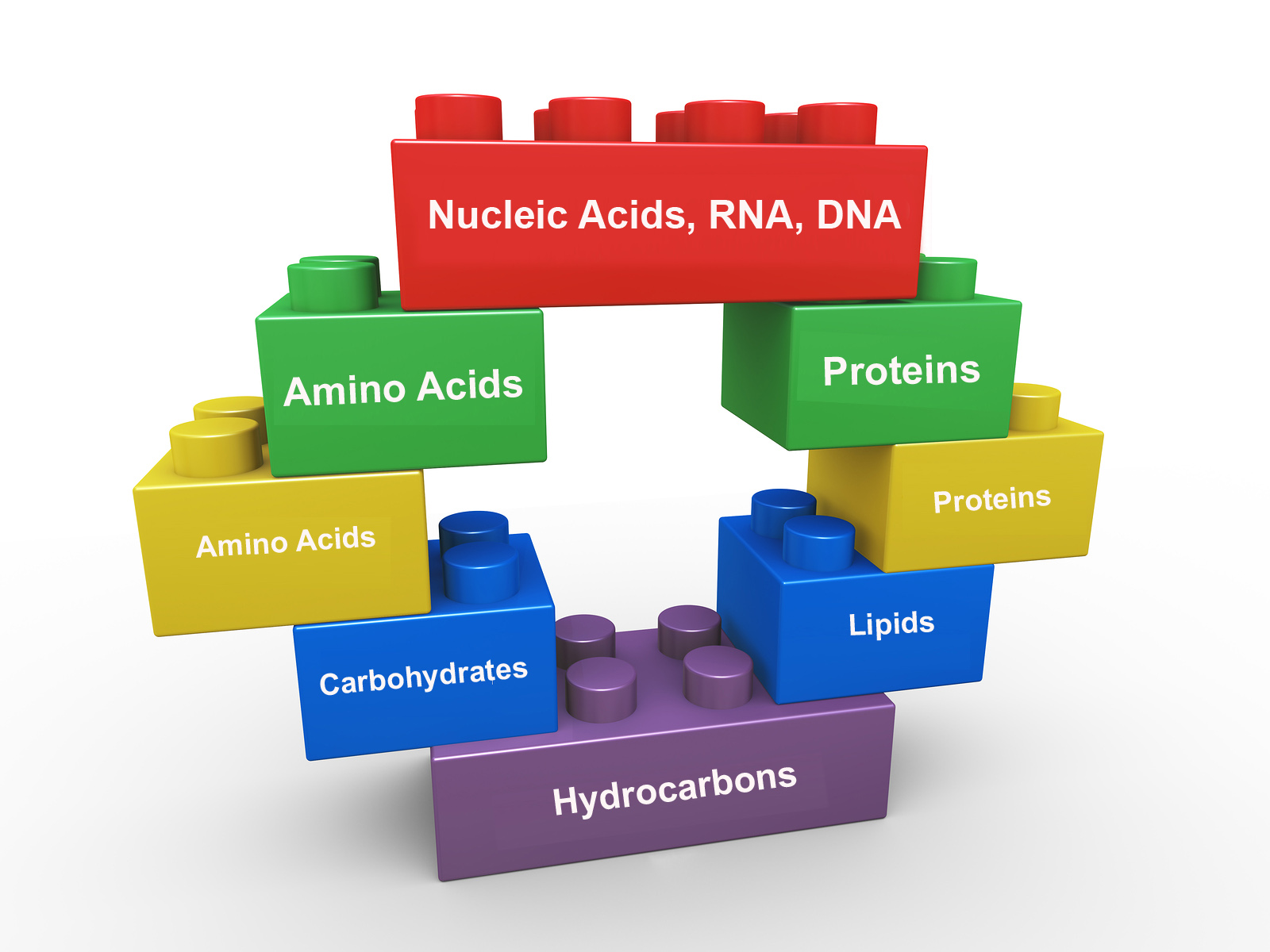 Legos can be a great
toy for learning if designed and used correctly.
I would like to see building blocks with more then just letters
on them. You can have the blocks with its measurements, blocks
with weight measurements, blocks with a load capacity, blocks with
engineering symbols, and so on. Emergence
- Factory Built Homes.
Legos can be a great
toy for learning if designed and used correctly.
I would like to see building blocks with more then just letters
on them. You can have the blocks with its measurements, blocks
with weight measurements, blocks with a load capacity, blocks with
engineering symbols, and so on. Emergence
- Factory Built Homes.Kids can be taught to make their own building Blocks, and make their own Learning Tools and Measuring Equipment. Kids can also use blocks for Knowledge Trees or to Visualize Mind Maps. Let them choose the colors, let them choose the weights, let them choose the texture, let them choose the scent, let them choose the shape, let them choose the sounds that each block makes, and let them choose how to label each block, so they can visualize in their mind what they want to see, something that makes sense to them, and makes it easier for them to remember. You can show them the best known arrangements, but let them know it can be modified to fit their particular needs.
See Touch Learn
LEGO Education SOFT Bricks Set 6033778 (84 Bricks)
These Jumbo Lego Blocks would be perfect to add labels to. A plastic sleeve to add and change labels would work.
LEGO-like blocks build new possibilities for microfluidics. Polydimethylsiloxane (PDMS) – a silicone-based organic polymer – to cast the building blocks of a truly LEGO-like microfluidics platform. Blocks are essentially 2×2 LEGO bricks with integrated microfluidic channels, cast from 3D-printed master moulds and actual LEGO parts. We put the modules together on a standard LEGO plate. Like traditional LEGO bricks, they are stackable, and their geometry makes mass production by injection moulding feasible.” A truly Lego®-like modular microfluidics platform.
Academics show how to create a spotlight of sound with LEGO-like bricks. Informatics experts create low-cost directional beams of sound.
Key Learning Targets: Developing gross manipulative and gross motor skills, Spatial awareness, Developing balancing, jumping, climbing, and crawling skills, Cooperation and teamwork, Physical development. And then if you put labels on the blocks, then you could learn a lot more, about all kinds of things.
You can also use blocks to show Software Development, Application Layers, Development Processes, Levels in Thinking, Organization Structures, Chemical Structures, Matrix Levels, Time Lines, and so on.
IU neuroimaging study: Building blocks activate spatial ability in children better than board games
Braille Building Blocks - Spatial Intelligence
Toy Block are pieces of various shapes (square, cylinder, arch, triangle, etc.) and colors that are used as construction toys (also building bricks, building blocks, or simply blocks).
Building Blocks (PDF) Block play and performance standards: Using unstructured materials to teach academic content.
Brixo - Building Blocks Meet Electricity and IoT. Bring your designs to life with electronic sensors, motors and connected apps.
BioBrick are building blocks used to design and assemble larger synthetic biological circuits from individual parts and combinations of parts with defined functions, which would then be incorporated into living cells such as Escherichia coli cells to construct new biological systems.
Flexo -Bendable, bouncy, flexible building bricks! Bounce, twist, bend, wrap or wear! Flexo uses a unique rigid brick and flexible tendon. Be creative!
Nimuno Loops - The Toy Block Tape instantly transforms virtually any surface into a base for Toy Building Blocks and components!
Cells (Building Blocks)
Cells are the smallest unit of life that can replicate independently, and are often called the "building blocks of life".
What's a cell made of ?...
Hydrocarbon is an organic compound consisting entirely of Hydrogen and Carbon.
Lipids are a group of naturally occurring molecules that include fats, waxes, sterols, fat-soluble vitamins (such as vitamins A, D, E, and K), monoglycerides, diglycerides, triglycerides, phospholipids, and others. The main biological functions of lipids include storing energy, signaling, and acting as structural components of cell membranes.
Carbohydrate is a biological molecule consisting of carbon (C), hydrogen (H) and oxygen (O) atoms.
Amino Acids are biologically important organic compounds containing amine (-NH2) and carboxylic acid (-COOH) functional groups, usually along with a side-chain specific to each amino acid. The key elements of an amino acid are carbon, hydrogen, oxygen, and nitrogen.
Proteins are large biomolecules, or macromolecules, consisting of one or more long chains of amino acid residues. Proteins perform a vast array of functions within living organisms, including catalyzing metabolic reactions, DNA replication, responding to stimuli, and transporting molecules from one location to another.
Nucleic Acids are biopolymers, or large biomolecules, essential for all known forms of life. Nucleic acids, which include DNA (deoxyribonucleic acid) and RNA (ribonucleic acid), are made from monomers known as nucleotides.
RNA is a polymeric molecule implicated in various biological roles in coding, decoding, regulation, and expression of genes.
DNA is a molecule that carries most of the genetic instructions used in the development, functioning and reproduction of all known living organisms and many viruses.
Building Blocks of Life (PDF)
Nucleobase are nitrogen-containing biological compounds that form nucleosides, which in turn are components of nucleotides, with all of these monomers constituting the basic building blocks of nucleic acids. The ability of nucleobases to form base pairs and to stack one upon another leads directly to long-chain helical structures such as ribonucleic acid (RNA) and deoxyribonucleic acid (DNA). Life's building blocks may have formed in interstellar clouds.
AP Biology The Chemical Building Blocks of Life (PDF)
Life's Building Blocks observed in Spacelike Environment
Component Parts are the uniquely identifiable input, part, piece, assembly or subassembly, system or subsystem, that (1) is required to complete or finish an activity, item, or job, (2) performs a distinctive and necessary function in the operation of a system, or (3) is intended to be included as a part of a finished, packaged, and labeled item. Components are usually removable in one piece and are considered indivisible for a particular purpose or use. Commonly, items of very small or insignificant cost are not considered components.
Component is an abstract part of something. Something determined in relation to something that includes it. An artifact that is one of the individual parts of which a composite entity is made up; especially a part that can be separated from or attached to a system.
Part is something determined in relation to something that includes it. Something less than the whole of a human artifact. A portion of a natural object. That which concerns a person with regard to a particular role or situation. The extended spatial location of something. One of the portions into which something is regarded as divided and which together constitute a whole.
Teaching Machine (youtube)
The Sport of Learning Cognitive workouts using Games and Simulations
Tiny Machines - Nano Building Blocks
You can even make other Building Games and Connection Games using toys like Dominoes, you can make a game of connecting Molecules, Atoms or Chemical Elements.
Folding Proteins made into a Game
CHON is the acronym which stands for carbon, hydrogen, nitrogen, oxygen, phosphorus, sulfur, represents the six most important chemical elements whose covalent combinations make up most biological molecules on Earth. Sulfur is used in the amino acids cysteine and methionine. Phosphorus is an essential element in the formation of phospholipids, a class of lipids that are a major component of all cell membranes, as they can form lipid bilayers, which keep ions, proteins, and other molecules where they are needed for cell function, and prevent them from diffusing into areas where they should not be. Phosphate groups are also an essential component of the backbone of nucleic acids and are required to form ATP – the main molecule used as energy powering the cell in all living creatures. Carbonaceous asteroids are rich in CHON elements. These asteroids are the most common type, and frequently collide with Earth as meteorites. Such collisions were especially common early in Earth's history, and these impactors may have been crucial in the formation of the planet's oceans. The simplest compounds to contain all of the CHON elements are fulminic acid and isocyanic acid (the latter of which is much more stable), having one of each atom.
Layers
A layer serves the layer above it and is served by the layer below it. For example, a layer that provides error-free communications across a network provides the path needed by applications above it, while it calls the next lower layer to send and receive packets that comprise the contents of that path. Two instances at the same layer are visualized as connected by a horizontal connection in that layer.
Interfaces - Structure
Lego builds anaesthesia skills according to new study. Lego could be used as a practical tool to train doctors in anaesthetic skills according to new research that has shown a simple task using the building bricks can help improve technical skills - a finding that could improve medical training and patient safety. The educational tool required students to view in a mirror two-dimensional images of three-dimensional models constructed from Lego Duplo® bricks. They then had to recreate the models they could see in the mirror. After they had completed building the models, they were able to compare them directly with the originals. If they failed the task, they were asked to return to the mirror and make good any errors. Scientists measured the students ability to perform ultrasound-guided injections on a laboratory model before and after this training and saw that students exposed to the Lego training performed the ultrasound task significantly better than students who did not receive Lego training.
"Blocks are made to be assembled, but who is deciding where the bricks go? Someone did, and that someone is not a person, that someone is "Fill in the Blank". There is no wrong answer, but everyone can't be right either."
"Lay each brick reverently. Lay a purposeful brick, but be in the moment of laying that brick. The house will form."
The ancient philosopher Plato posited the shapes of the building blocks of the universe. According to him, the earth was formed of cubes. Researchers now find a fundamental truth in that premise. Studying the shapes and fragmentation patterns of a variety of rocks, they found that the average of all their forms is a cube.
Resources - Learning Games - Educational Toys
Learning Toys - Learning Resources - Educational Learning Games
 Manga High
Manga HighXP Math Games
Math Run
Fun Brain
Math Play Ground
Shiftables (youtube)
Little Zen Minds
Brilliant effective learning is interactive, not passive. Brilliant helps you master concepts in math, science, and engineering by solving fun, challenging problems.
Gifted Kids
Mutable transforms from a design table into an all-in-one play table for children ages 1 through 8.
Natural Wood Toys
Mind Tools
Knox Cubes is a nonverbal intelligence test.
Arcademic Skill Builders
Brain Metrix
Braingle
Innovations for Learning
Quest to Learn
Humana Games
Poptropica
Video Game Safety Ratings
G4 TV Video Games Reviews
Dangers of Sitting for a Long Time
Role Playing Game is a game in which players assume the roles of characters in a fictional setting. Players take responsibility for acting out these roles within a narrative, either through literal acting or through a process of structured decision-making or character development. Actions taken within many games succeed or fail according to a formal system of rules and guidelines.
Live Action Role-Playing Game is a form of role-playing game where the participants physically act out their characters' actions. The players pursue goals within a fictional setting represented by the real world while interacting with each other in character. The outcome of player actions may be mediated by game rules or determined by consensus among players. Event arrangers called gamemasters decide the setting and rules to be used and facilitate play.
Engineering Model Building Kits
 Architectural Model Building Kits
Architectural Model Building KitsKEVA Structures 200 Plank Set
Engineering Building Kits
Building and Construction Sets
Architecture Building Kits
Architect Gifts Plus
Building Blocks
3D Printing - Architecture
Prototypes - Drawings
Engineering
Architectural Precision Models
Design
Architecture
Science Kits and Tools
Kinetic Sand
Problem Solving Games
Kids Math Games
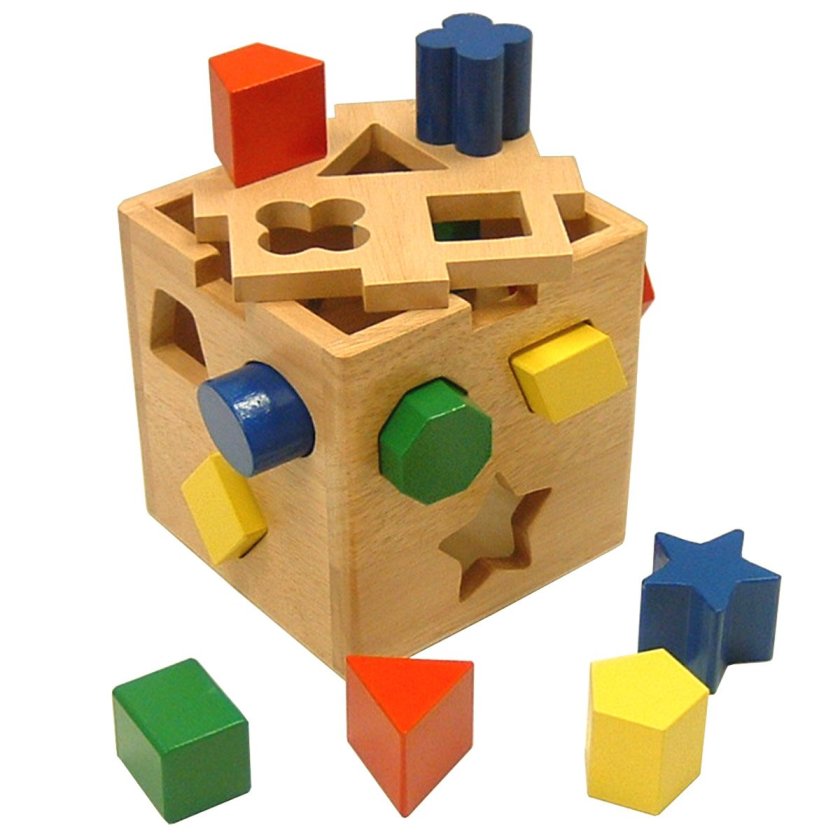 Learn English
Learn EnglishAbcya
Sesame Street
Poisson Rouge
Learning Tools
Educational Software
Consumer Protection
Word Games - Charades
Brain Games
Conversation Games are games that require only conversational ability. Conversation games owe their popularity to their ability to be played almost anywhere with almost anyone and for their ability to generate conversation.
Twenty Questions (PDF)
Word Matrix
Pictionary is a charades-inspired guessing word game played with teams with players trying to identify specific words from their teammates' drawings.
Mental Rotation (spatial intelligence)
The Learning Tree
Learning Games for Kids
Goldie Blox
Uncle Goose
My Atoms
Ever Loop
The Problem Site
Sports and Games - Learning Disabilities
Museum of Play National Toy Hall of Fame, an interactive collections-based museum with the History of Electronic Games and Archives of Play.
The Full History of Board Games
History of Graphics in Video Games (youtube)
50 Toys of the last 50 Years (info-graph)
Photographer Gabriele Galimberti takes an intimate look at Kids and their Toys
Learning Laptop - Online Education
Tests That Look Like Video Games
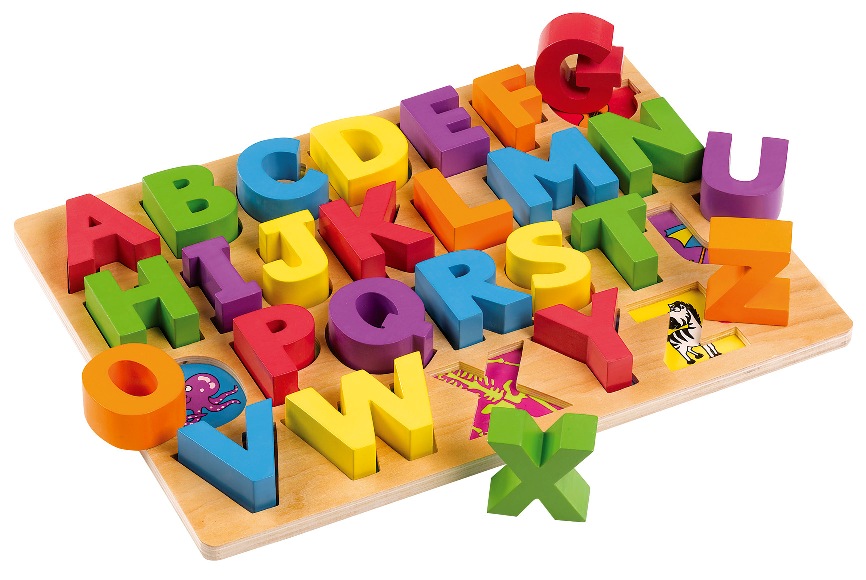
Stanford
Virtual Reality - Smartphone Capabilities - Testing Knowledge
Wonder Brains - Fat Brain Toys - Learning Works for Kids - Find the Right Toy
Legos - Building Blocks - Science Websites - Brain Websites - Robotics
Curious Minds - E Science Labs - Home Training Tools
Brain Exercises - Brain Teasers - Cognition Tests
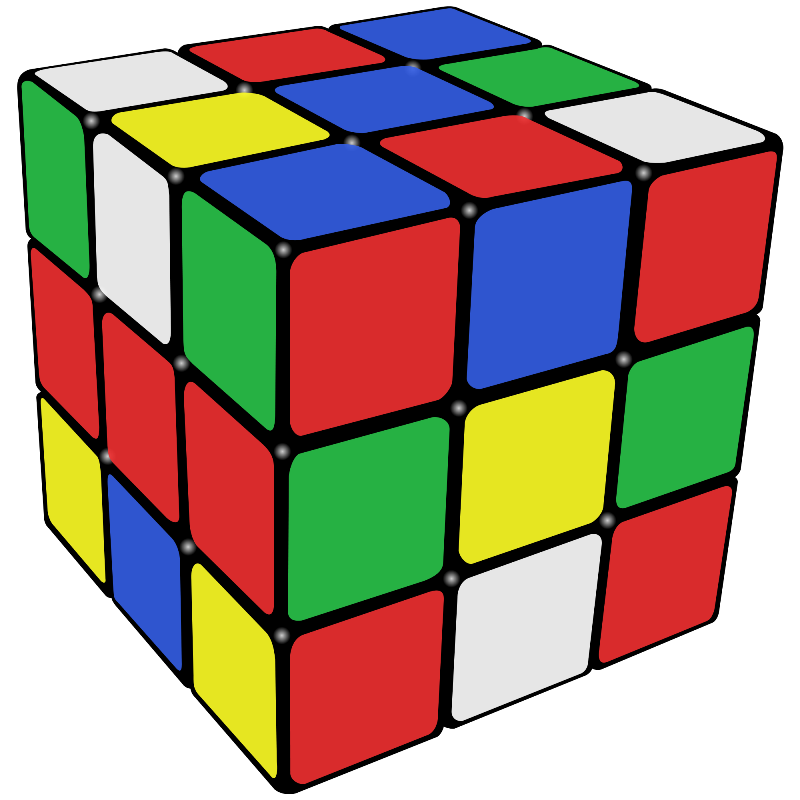 The best thing about brain teasers is that they
force you to listen,
focus and
think, which people don't do
enough of. But most brain teasers are not reality based, so you will never
use that information in real life. So if you are going to exercise peoples
ability to listen and focus, you better do it in a way that has
real life examples,
something they will use in reality.
The best thing about brain teasers is that they
force you to listen,
focus and
think, which people don't do
enough of. But most brain teasers are not reality based, so you will never
use that information in real life. So if you are going to exercise peoples
ability to listen and focus, you better do it in a way that has
real life examples,
something they will use in reality.Cog Med - Cog Ni Fit
Elevate-Brain Training
Fit Brains Apps
Pymetrics
Lumosity
Test My Brain
Speed of Processing Cognitive Training
Double Decision (video)
Braingle Brain Teasers, Riddles, Trivia, Brain Exercises, Games, Forums and more..
Brain Teaser is a form of puzzle that requires thought to solve. It often requires thinking in unconventional ways with given constraints in mind; sometimes it also involves lateral thinking. Logic puzzles and riddles are specific types of brain teasers.
Intelligence Testing
Memory Games
Physical Exercise Improves Memory
Memory Enhancers
The Problem Site
Brain Bashers - Collection of Brain Teasers, Puzzles, Riddles, Games and Optical illusions.
Thousands of Quizzes, or Create Your Own
Difference Between
Retrocade
Games, Illusions, Magic
Open Mind
Second Life
Moblab Interactive Social Science Games
Animation Creation Software - Make your own Cartoons
Toy Association - Pre School Games - Play Kids Games - Learning Planet - Tinkering School
Arvind Gupta: Trash into Toys for Learning (youtube) - Arvind Gupta Toys
Toys to Grow On - Fisher Price - Funschool Kaboose
Puzzles
 Puzzle is a game,
problem, or toy that tests a
person's ingenuity or knowledge. In a puzzle, one is required to put
pieces together in a logical way, in order to arrive at the
correct solution of the puzzle. There are different types of puzzles for different
ages, such as crossword puzzles, word-search puzzles, number puzzles, or
logic puzzles. Geometry.
Puzzle is a game,
problem, or toy that tests a
person's ingenuity or knowledge. In a puzzle, one is required to put
pieces together in a logical way, in order to arrive at the
correct solution of the puzzle. There are different types of puzzles for different
ages, such as crossword puzzles, word-search puzzles, number puzzles, or
logic puzzles. Geometry.Puzzle is something that is a mystery or something bewildering and uncertain. A particularly baffling problem that is said to have a correct solution.
Tiling Puzzle are puzzles involving two-dimensional packing problems in which a number of flat shapes have to be assembled into a larger given shape without overlaps (and often without gaps). Some tiling puzzles ask you to dissect a given shape first and then rearrange the pieces into another shape. Other tiling puzzles ask you to dissect a given shape while fulfilling certain conditions. The two latter types of tiling puzzles are also called dissection puzzles.
Perplexed is something completely baffling or very puzzling. Full of difficulty, confusion or bewilderment.
If you are missing too many pieces to your puzzle, then you will not have a clear picture or see the whole picture.
Logic Puzzle is a puzzle deriving from the mathematics field of deduction.
Math and Logic Puzzles
Puzzles
Sudoku (wiki)
Math Puzzles
Puzzler
Puzzle Hunt
Match Puzzle (move only 2 sticks)
Portrait Puzzles
Jigsaw Puzzles from your Photos
Tangram is a dissection puzzle consisting of seven flat shapes, called tans, which are put together to form shapes. The objective of the puzzle is to form a specific shape (given only an outline or silhouette) using all seven pieces, which may not overlap.
JS Puzzles
Jigsaw puzzles with the same die cut pattern make terrific mashups.
Logic Games
Algebraic Reasoning
Logic Games
Logic Games Online
School Time Games
Logifaces Analogue Game for Digital Minds
Escape Room or escape game, is a game in which a team of players cooperatively discover clues, solve puzzles, and accomplish tasks in one or more rooms in order to progress and accomplish a specific goal in a limited amount of time. A team of people signs up to be locked in a room, and must find clues and solve puzzles to complete a given mission and find the key to escape.
Game Mechanics are constructs of rules or methods designed for interaction with the game state, thus providing gameplay. All games use mechanics; however, theories and styles differ as to their ultimate importance to the game. In general, the process and study of game design, or ludology, are efforts to come up with game mechanics that allow for people playing a game to have an engaging, but not necessarily fun, experience.
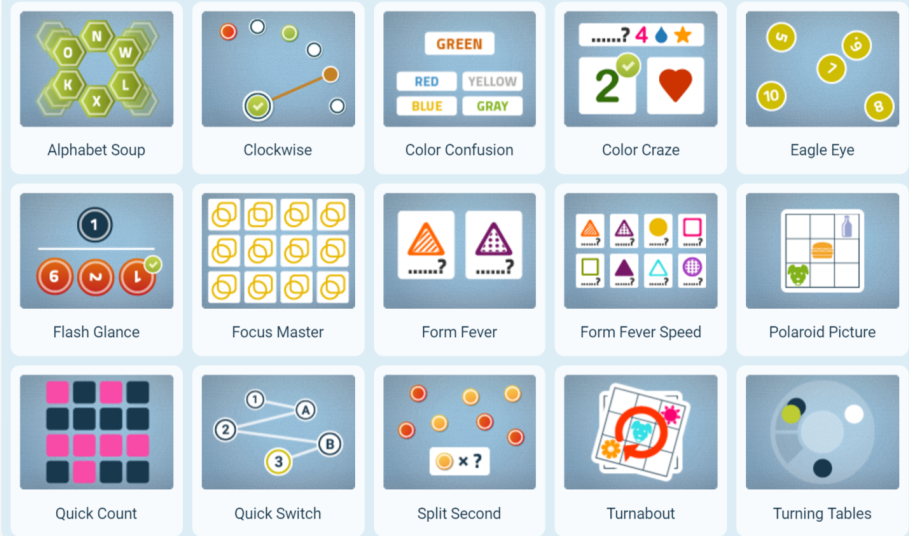 Game Star Mechanic
Game Star MechanicThe Legend of Zelda (wiki)
Learn to Write Code
Playopolis Toys
Child Therapy Toys
Educational Innovations
Brainwashers Video Game Idea
Raven Progressive Matrices
Visual Tracking Inspection Time
Eye Tracking
Video Tracking
Eye can Learn
Learning RX
Dual-n-Back
Serious Play
Marbles the Brain Store
Melissa and Doug
Rives: Reinventing the Encyclopedia Game (youtube)
Test your Geography Knowledge
E Spark Learning on I-Pads
Create Lessons on I-Pad
Related Subjects - Learning Styles - Problem Solving - Bodily-Kinesthetic Intelligence - Information Literacy - Creativity - Music - Art - Intelligence - Memory - Technology Learning Tools - Focus - Self-Control.
Video Games I played at work in the late 90's, but after work, I did not want to play these games, I wanted to learn instead of just playing games.
Wolfenstein 3D - Played against the game, very addicting. Learned to save last level so I would not have to start from the beginning each time I was killed, which a was a lot.
Descent - Awesome 3D flying game. I played against other people at work using our companies server. Then when half-life came out, everyone played half-life and we never played the game descent again.
Half-Life - Very addictive game, you can play against other people and with other people.
I also played pong on my home TV set, which was developed in 1972. I also played the arcade game asteroids, which was made in 1979 but was originally created at MIT in 1961, they called is spacewar video game.
"Just because things are similar does not mean that they are the same. We create virtual reality to imitate certain aspects of life, but just because you can imitate life, this does mean that life is an imitation. You can create games in life, but this does not make life a game."
We have been Illuminated
Lumosity made false claims, just like most corporations do and just like most schools do. And of course Lumosity did it just for the money, just like most corporations do and just like most schools do. And the excuse they gave was simply pathetic. Our a**hole days are coming to an end people. We need to end this a**hole behavior, because this sh*t storm is killing us. We need to rethink and retool ourselves so that we can accommodate our new level of knowledge and understanding, which has given us a more clearer perspective of our reality and situation. Cause and effect is not imaginary, it is extremely real and sometimes deadly. Cause and effect is verifiable to anyone, so ignoring this fact of nature could, and will continue to have tragic consequences. But on the Brightside, cause and effect also has many rewards and benefits. We have to make better choices, choices that have much better outcomes. So let's stop f*cking around, and let us get to work. We have a lot of problems to solve, and these problems are not going to solve themselves. We have a responsibility to the quadrillions of people who will live after us.
2007 study published in Behavioral and Brain Sciences assessed the impact of brain training games on fluid intelligence. After participants played Tetris--yes, Tetris--for several weeks, cortical thickness and cortical activity increased. Both are signs of an increase in neural connections and learned expertise. In simple terms, their brains bulked up and got smarter. But after those first few weeks, cortical thickness and activity started to decrease, eventually returning to pre-Tetris mastery pursuit levels--even though their skill levels remained high. Participants didn't lose brain power. Instead, their brains became so efficient at playing Tetris those increased neural connections were no longer necessary. Using more mental energy was no longer necessary. As with most things, once they kinda figured it out, it got easy.
Accommodate is to be agreeable or acceptable to. Make fit for, or change to suit a new purpose. Provide with something desired or needed.
Illuminated is to make free from confusion or ambiguity; make clear.
Do “Brain-Training” Programs Work? Brain-Training Pessimism, but Applied-Memory Optimism.
Marketers of One-on-One ‘Brain Training’ Programs Settle FTC Charges That Claims about Ability to Treat Severe Cognitive Impairments Are Unsupported.
Affordability should never be about money, It has to be about knowing the most effective and efficient ways for fulfilling our needs. It has to be about fully understanding all the different elements that surround our lives, and all the different cause and effects that come from our needs, and the actions we take that are related to those needs. So when we teach math, we need to teach students how to accurately calculate the impacts of their life. And whether those impacts are sustainable, or, whether those impacts will eventually damage something or kill something. We can't ignore reality, reality is all we have. There is no alternate universe, there is no other planet.
I implore you to see reason.
Rock–Paper–Scissors is a hand game usually played between two people, in which each player simultaneously forms one of three shapes with an outstretched hand. These shapes are "rock" (a closed fist), "paper" (a flat hand), and "scissors" (a fist with the index finger and middle finger extended, forming a V). "Scissors" is identical to the two-fingered V sign (aka "victory" or "peace sign") except that it is pointed horizontally instead of being held upright in the air. A simultaneous, zero-sum game, it has only two possible outcomes: a draw, or a win for one player and a loss for the other. A player who decides to play rock will beat another player who has chosen scissors ("rock crushes scissors" or sometimes "blunts scissors"), but will lose to one who has played paper ("paper covers rock"); a play of paper will lose to a play of scissors ("scissors cuts paper"). If both players choose the same shape, the game is tied and is usually immediately replayed to break the tie. The type of game originated in China and spread with increased contact with East Asia, while developing different variants in signs over time. Other names for the game in the English-speaking world include roshambo and other orderings of the three items, with "rock" sometimes being called "stone". Rock–paper–scissors is often used as a fair choosing method between two people, similar to coin flipping, drawing straws, or throwing dice in order to settle a dispute or make an unbiased group decision. Unlike truly random selection methods, however, rock–paper–scissors can be played with a degree of skill by recognizing and exploiting non-random behavior in opponents.
Morra two-player version is when one person is designated the "odds" player while the other is labeled "evens". Players hold one hand out in front of them and count together to three (sometimes chanting "Once, twice, thrice, shoot!" or "One, two, three, shoot!"). On "shoot", both players hold out either one or two fingers. If the sum of fingers shown by both players is an even number (i.e. two or four) then the "evens" player wins; otherwise the "odds" player is the winner. Since there are two possible ways to add up to three, both players have an equal chance of winning. In New York City and Long Island in the 1950s, the game was called "choosies," and would be invoked to resolve a playground dispute by one antagonist saying, "let's shoot for it." In Boston at about the same time, the term in use was "bucking up." In US Coast Guard wardrooms (officer's mess), players "shake out." It has also been referred to as "odds-on poke." Morra can be played to decide issues, much as two people might toss a coin, or for entertainment. While there are many variations of morra, most forms can be played with a minimum of two players. In the most popular version, all players throw out a single hand, each showing zero to five fingers, and call out loud their guess at what the sum of all fingers shown will be. If one player guesses the sum, that player earns one point. The first player to reach three points wins the game. Some variants of morra involve money, with the winner earning an amount equal to the sum of fingers displayed. Each player simultaneously reveals their hand, extending any number of fingers, and calls out a number. Any player who successfully guesses the total number of fingers revealed by all players combined scores a point.
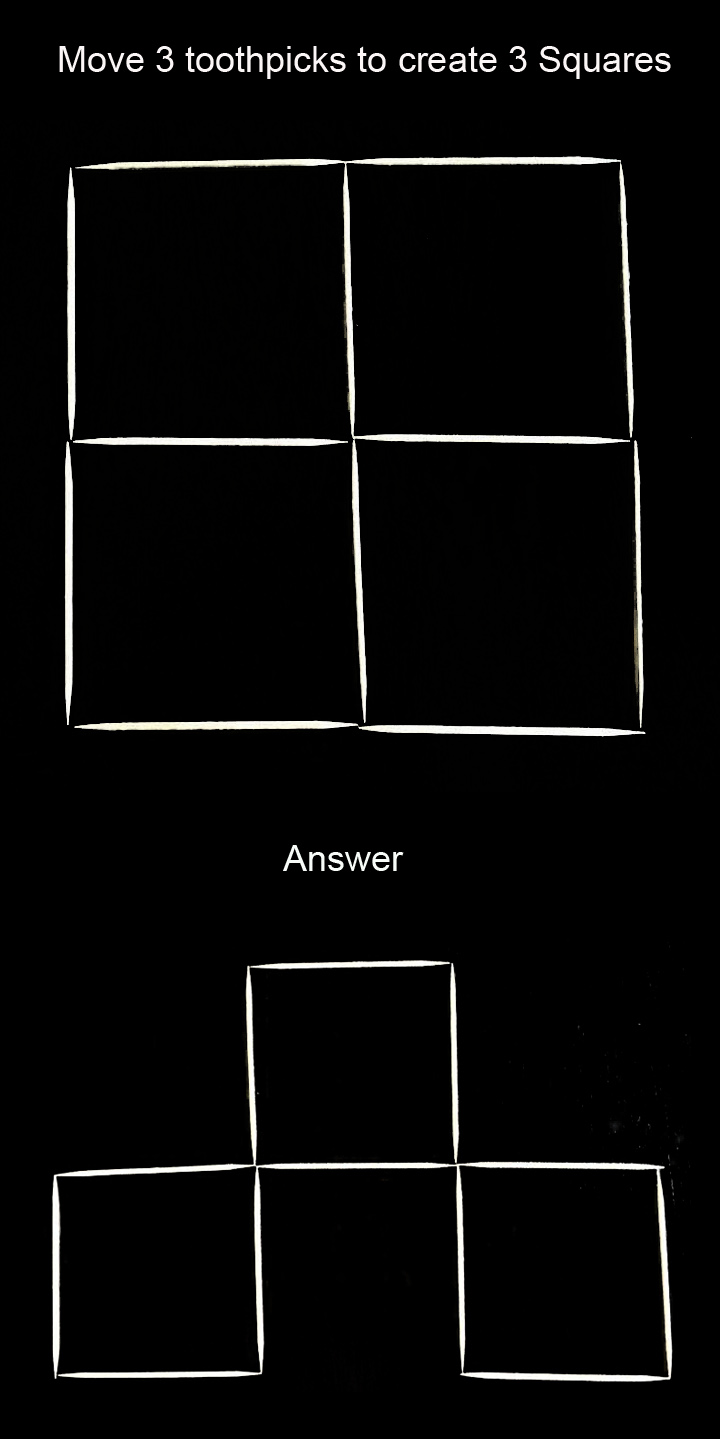
Using 10 coins, turn this pyramid upside down by moving only 3 coins.

